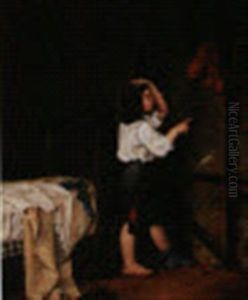Alfred Pommier Paintings
Alfred Pommier was a French sculptor born in 1824, in a period marked by the Romantic Movement, which influenced various forms of art, including sculpture. His life spanned much of the 19th century and the early years of the 20th, a time of significant political, social, and artistic change in France and across Europe. Pommier's works are less widely known than those of his contemporaries, such as Rodin, but he contributed to the rich tapestry of French sculpture with his unique style and thematic focuses.
Pommier trained at the École des Beaux-Arts in Paris, the premier French school of art and architecture. His education there would have immersed him in both the classical traditions of sculpture, drawing from ancient Greek and Roman art, and the evolving tastes of the modern world. He exhibited at the Paris Salon, a prestigious venue for artists to display their works to the public and be critiqued by their peers. This exposure would have been crucial for establishing his reputation in the competitive Parisian art scene.
Throughout his career, Alfred Pommier explored various themes, often focusing on allegorical subjects and historical figures, which were popular among the public and critics of the time. His sculptures, characterized by their detailed realism and emotional depth, reflected the Romantic interest in expressing the sublime and the beautiful, as well as the human experiences of love, loss, and triumph. Pommier's work was part of the broader movement in 19th-century European art that saw a return to craftsmanship and beauty, reacting against the industrialization that was transforming society.
Despite his contributions to French sculpture, Alfred Pommier's legacy has been somewhat overshadowed by the towering figures of his era. However, his works remain a testament to the vibrancy and diversity of 19th-century French art. Pommier's sculptures can be found in various French museums and public spaces, where they continue to be appreciated by art lovers and historians. He died in 1911, leaving behind a body of work that, while not as celebrated as that of some of his peers, is nonetheless an important part of the history of French art.

